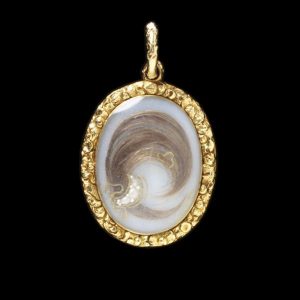 Tiffany Watt Smith is a research fellow on the ‘Living with Feeling’ grant at the Centre for the History of the Emotions.
Tiffany Watt Smith is a research fellow on the ‘Living with Feeling’ grant at the Centre for the History of the Emotions.
She is the author of The Book of Human Emotions and On Flinching: Theatricality and Scientific Looking from Darwin to Shell-Shock
Deborah Lutz, Relics of Death in Victorian Literature and Culture (Cambridge University Press, 2015)
For four generations, my family has lovingly tended a ghoulish heirloom – a severed horse’s hoof, set in silver and turned into an inkwell. It originally belonged to the favourite nag of my great-great grandfather, who drove a London ‘growler’ or horse-drawn cab in the 1880s. When I run my fingers over it, unexpected emotions rise up in me. Sometimes I think I can feel a faint echo of the love felt between the animal and its original owner. Or the exhaustion they must have experienced as each new passenger boarded the cab. Perhaps this is mere fanciful nostalgia on my part. Could a horse’s hoof really contain a residue, a patina, of its emotional past?

Silver inkwell made from the hoof of ‘Anstey’ the horse of Colonel Guy Hamilton, © National Army Museum. http://www.nam.ac.uk/online-collection/detail.php?acc=1995-07-46-
Many of us inhabit lives crammed with belongings, with stuff. Yet, for all our apparent attachment to things, it can be hard to find a language to talk about the feelings objects arouse. It’s spooky enough to talk of a glove or book or inkwell as somehow harbouring the emotions of its previous owners. Yet, encounter some object from the past, and it may well feel as if some of its previous lives still pulse within it. Deep in the archives, a letter exchanged by two eighteenth-century lovers is not only thrilling for its content, but for its smudges, its marginalia, its wine stains (or are they splashes of blood?) that seem to re-animate long dead emotions. In our libraries and archives, the emotional resonance of such pieces – be they strips of flayed skin or locks of hair, pressed flowers or collections of feathers – are hidden behind their categorization as ‘3-D objects’ or ‘ephemera’. But if today, talk of objects having emotions seems eccentric at best, this was not entirely the case for the Victorians, who as Deborah Lutz has explored in her rich and fascinating Relics of Death in Victorian Literature and Culture, were at home with the emotional pull the inanimate world has on us.
Lutz, a literary theorist, is of course not the first to explore the importance of the material world in Victorian culture. Like Elaine Freedgood, Hermione Lee and many others, Lutz’s contention is that literature is capable of both reflecting and shaping our interactions with the inanimate. Her focus, however, is more specifically on the dead human body-turned-thing. She asks how hair, teeth, bones, skin and even organs were absorbed into the era’s elaborate rituals of grief, and in turn, influenced changing conceptions of subjectivity at that time.
For Lutz, body part relics are particularly intriguing, since they offer a clear example of what it means to think with ‘things’ as opposed to ‘objects’. In his much-discussed article on ‘thing theory’, Bill Brown explains that ‘we begin to confront the thingness of objects when they stop working for us’, escaping the boundaries of their expected function and becoming hard to define. Lutz argues that body part relics inhabit this blurry in-between. They are both actual and metaphysical, secular yet with a ‘dash of magic’. What’s more, body part relics have meaning precisely because of their authenticity – yet, as Lutz intriguingly explores, their provenance is often in doubt. Most of all, body part relics are part of peculiar transformations, muddling the boundaries between life and death. As Brown ponders, ‘Why…does death have the capacity both to turn people into things and to bring inanimate objects to life?’.
Lutz’s answer to this question begins with the tale of Shelley’s heart. Miraculously surviving the poet’s cremation in Italy (so the story goes), the heart was snatched from the embers by his friend Trelawny, and carried back by Mary Shelley to England where it was wrapped in silk, and stored in a copy of Shelley’s Adonais, and finally buried with their son Percy Florence in 1889. Lutz, while raising questions about the reliability of this tale (among others: how could Shelley’s apparently larger-than-normal heart be stored between the pages of what is essentially a pamphlet?), approaches Shelley’s heart as a ‘secular relic’, recalling the older European tradition of storing the severed fingers or bones, or withered heads of saints in ornate reliquaries. If saints’ relics could levitate, weep and cure the ailments of those who touched them, so for the Romantics, the lost genius of the poet lingered on in their bodies as much as in their writing.
Moving forward through the century, Lutz finds many other intersections of body and book. In the Brontë household at Haworth, everyday items such as a sofa, a writing desk and clothes are mementos through which ‘absence comes to feel material’ (encountering the material culture of these writers’ lives is the subject of her enjoyable recent book The Brontë Cabinet). The third chapter discusses posthumous representations such as death masks and waxworks, pitting these deliberate memorials against the unintended bodily deposits of sweat and skin. For instance, in Great Expectations, the walls of lawyer Jaggers’s office are ‘greasy with shoulders’, and there is a dark wash along the staircase from years of ‘shuffling up and down’. As Lutz puts it, ‘such leavings…provide an ever-present reminder of how bodies are not just the container for ‘selves’ but they are also substances that leak and rot…’, always transforming, always testing the limits between subject and object. The fourth chapter more tenuously discusses shrines and tombs as spaces which have ‘witnessed the living of the loved one’, linking these animated spaces to those enchanted rooms familiar from the mid-nineteenth century fashion for Spiritualism. The final chapter, however, returns squarely to the business of things, addressing the ubiquitous Victorian practice of hair jewellery (for a discussion of contemporary ‘hair-work’ see Bharti Parmar’s post on this blog).

Locket and chain, c. 1810 by John Miers, England ©Victoria and Albert Museum, http://www.vam.ac.uk/blog/artists-residence-va/hair
Hair-jewellery, already established by the 17th century, flourished in the 19th, with brooches, lockets, watch fobs, earrings and buttons all featuring intricate designs woven out of a dead loved-one’s hair. It was a laborious process: boiling, cleaning, straightening the individual strands with weights, and then the weaving itself. Many families sent packets of curls away to jewellers with instructions of the design to be completed – and in turn, rumours began to circulate that unscrupulous jewellers were substituting the real hair for another person’s (or even animals’) locks, whose strands were thicker, and longer, and so easier to work with.
In this growing suspicion about the provenance of hair jewellery for mourning, it is possible to see fractures in the idea – taken so much for granted earlier in the century – that to hold part of a loved-one’s body was to connect with that lost person. With the increasing medicalization of dying towards the end of the nineteenth century, the dead body became shrouded behind hospital screens, and the idea of plundering it for keepsakes perceived as unhygienic. The First World War is widely thought to have put an end to elaborate Victorian mourning rituals. As Joanna Bourke has explained, grieving became muted, with extended farewells not only impossible but also unpatriotic. Perhaps too, it was the spectre of anonymous graves, and fields in which blown-apart bodies mingled in the mud, that put an end the practice of retrieving body parts for use in mourning and memorial – and made any thoughts of a live and enduring connection between dead body and person seem, in the end, a kind of nostalgia.
